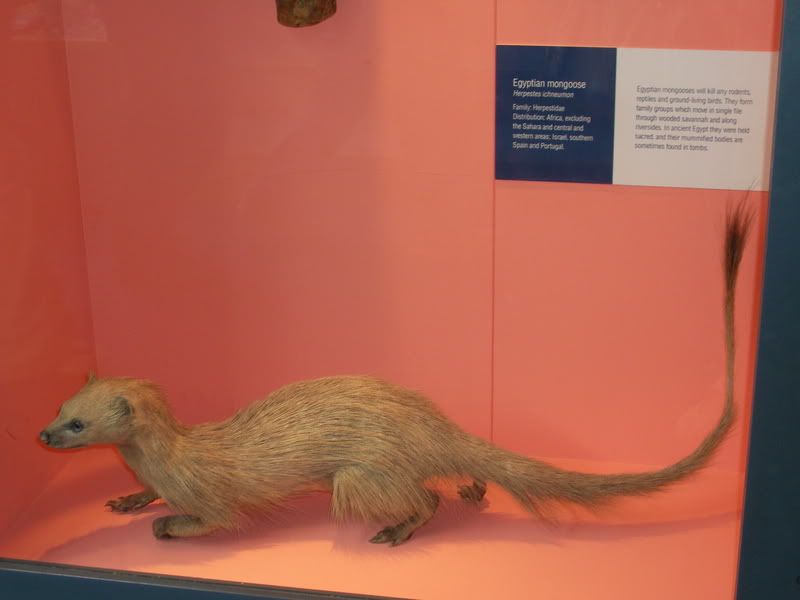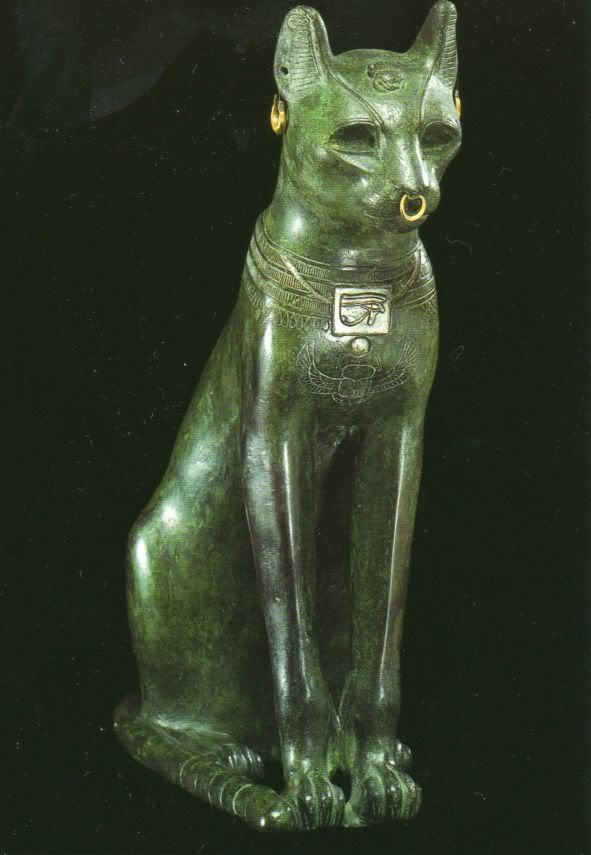Thursday 14 August 2008
Cats of the Ancient World
For the past forty-million years, cats have naturally made their homes on every continent on Earth, apart from Antarctica and Australia, having the same origins as dogs, raccoons, bears, and pigs. The cat evolved from a branch of the family called miacis, which contained all these animals mentioned, though the other animals emerged from a separate branch to the cat. Around twelve-million years ago, the true cat finally evolved, bringing about the South American Wildcat, Tuscany Jaguar, Lynx, and Cheetah. Wild cats of the world started to become domesticated by ancient peoples, though it is unknown exactly when the cat was first domesticated and which culture was responsible for making this step. It is sometimes suggested that the ancient Egyptians were the first to tame cats, possibly after discovering the slim, golden cats from Nubia, where they were considered the bringers of good luck. One of the ways of trying to discover when cats first became domesticated is by looking at evidence of cat remains and cats in artwork at burial sites, or any other human-orientated site. Remains of cats exist at Jericho (Israel) dating to approximately nine-thousand years ago and at Harappa (Indus Valley) from about four-thousand years ago; both in the form of a cat's tooth. Pottery depicting what is supposedly a wildcat has also been discovered at Jericho, dating to approximately 6700 BC. Dating to around seven-thousand years ago, more cat remains were discovered in association with humans at Cyprus. This find is very significant in that there is no cat in the fossil record at Cyprus prior to humans first immigrating there, so humans must have taken the cats there with them, possibly as family companions, though evidence shows that they were still physically wild cats. Dating to around 2700 BC, an ivory figurine of a resting cat was discovered at Lachish (Israel), as well as a terracotta cat head found at a Minoan site at the eastern shore of Crete. There was also a cat footprint found in a Roman Period town in England; the footprint was made in a tile, possibly from a domesticated or tamed cat, as it would be unlikely that a wild cat would choose to loiter about at human worksites. The remains of wild cats have even been excavated at Pre-historic grave sites in Egypt. At Abedju (Abydos) in Upper Egypt, seventeen cats accompanied by offering bowls were discovered in a mudbrick pyramid. What is hard to ascertain from these finds, and others, is whether these are the beginings of taming and domestication of wild cats in these areas, and if so, had it been going on many years prior to them being buried? When a wild cat was first bred in captivity amongst humans and made to live closely with them, not only does the cat's physical appearance begin to alter (body size and coat colour primarily), but their character changes, too. Having a human about to leave food out for them, giving them comfortable shelter night after night, and tending to them when they are ill, keeps a cat in permanent infantile stage which they never quite grow out of; this means that a cat is always kitten-like and the cat then needs the human interaction to keep happy. Therefore, eventually a wild cat - or indeed, many animals - kept in captivity will become tame and loving to their owners. This is what eventually took place in the ancient world, regardless of where and when, and this is what led to modern people having cats in their home from many different species of feline from different parts of the world.
Saturday 19 July 2008
The Cat in Ancient Egypt
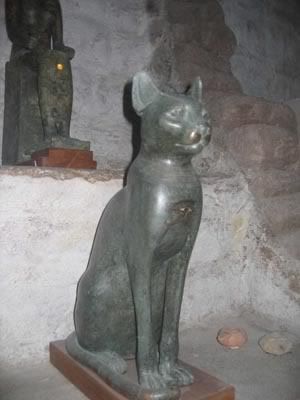
[Above - Cat statue representing Bastet from the Field Museum, Chicago, Illinois. This cat is shown wearing a menet collar, and has a wadjet eye on its chest and a scarab on its forehead. It also has banded markings in its fur on the tail. Photo supplied by John V. DeWerd.]
The cat in ancient Egypt was called the "miw"; they were called this simply because the "meow" is the sound a cat makes when interacting with humans, as well as this being the sound kittens make to their mother. Unlike many other animals in ancient Egypt, cats were hardly ever given names, and seem to have just been referred to as "miw" (cat). This is unusual, considering that people were often named after animals themselves, including the cat; for example, one name that became popular for people to be named was "Pa-Miu" (the tomcat). These cats were depicted with plain coats, tabby stripes, or with spots. Scenes of cats in the Middle Kingdom are usually represented in bird hunting depictions that take place in a papyrus skiff or thicket. Cats in these types of settings appear to have taken over Old Kingdom versions; whereby an Egyptian mongoose or genet had been depicted out on a hunt in earlier times instead of the cat. When cats began to replace them in these scenes they are shown usually balancing precariously on one or two papyrus stalks or umbels with a prized bird in its jaws or in its claws. It is unknown, with any certainty, if these cats at this time were domesticated, tamed, or still wild, by looking at the scenes alone, but it is often assumed that, because they are helpful in bird hunting, in that they disturb the birds from the papyrus marshes making it easier for the hunter to hit the bird with his throwstick, they were likely at least tamed animals, if not fully domesticated.
The earliest evidence of fully domesticated cats comes from the banquet scenes, which became more popular during the New Kingdom. These often show a deceased couple seated beside each other with stacks of food being offered to them in the afterlife. Beneath the chairs of the couple, things were often placed what they would like to take with them to the afterlife; this often included animals that were obviously beloved pets, like monkeys, dogs, birds, and cats (the earliest example of this type of scene is now currently in the Petrie Museum, London, England). You can be sure that these animals depicted beneath chairs were indeed family pets, as they were sometimes even shown with leashes around their necks or with a bowl of food beside them. Also, anyone that has owned a small animal will know that they just love to sit beneath their master's chair, so this is a very accurate representation of the actions of a pet. Traditionally, certain animals in ancient Egypt were owned by a specific sex; women tended to be shown with gazelles, birds, and cats, whereas men were shown more with dogs and monkeys, although there is a very touching scene with a cat sitting beneath her owner's seat (that of a lady), whilst her kitten is playing on the knee of the of the man sitting beside the lady. This scene can be viewed in the tomb of the craftsman, Ipuy, at Theban Tomb 217 from the reign of Ramessu (II). When cats were first kept as pets -either as a family pet, or a village companion - it would most likely have been with the knowledge that cats would protect homes, villages, and grain stores, from mice, rats, and snakes. This led to a mutually beneficial relationship developing between human and cat, and as domestication of cats increased, the size of the wild cat's body and muscle tone reduced because of change in diet and activity, as well as their coats becoming more colourful because of camouflage for survival no-longer being necessary. In ancient Egypt, cats were regarded as sacred; even the moisture on the cat's nose was seen as holy!
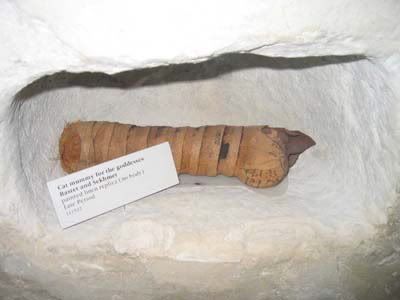
[Above - Mummified cat from the Late Period, taken at the Field Museum, Chicago, Illinois. Only the head of a cat was actually wrapped in this case; the rest is just stuffing. Photo supplied by John V. DeWerd.]
Cats were also mummified in ancient Egypt. This could be for two very different reasons. The first cause for a cat to be mummified was so that a beloved pet could reach the afterlife, just like its human counterparts. An example of this is shown by the beautiful limestone sarcophagus that Prince Djehutymose (son of Amenhotep III and elder brother of Amenhotep IV/Akhenaton) had made for his she-cat after her death (now in the Cairo Museum, Egypt). The text on the sarcophagus refers to the cat as "Usir (Osiris), she-cat" and along the left and right side of the box the cat sitting in front of a table of offerings is depicted; behind the cat on the right-hand side, there even stands what could be a feline-headed ushabti, so that this precious cat will be free from labour in the afterlife, or more likely, just an image of the she-cat herself. The great historian, Herodotus, says that in his lifetime (the Late Period of ancient Egypt), if a house were to catch fire, people would only be concerned about saving their cats and not their property. Also, according to Herodotus, if, and when, a family cat were to die, the tradition of the distraught owners was to shave off their eyebrows in mourning and take the cat to Per-Bast (Bubastis), the home of the cat goddess named Bastet, to be buried. The owner of the deceased cat often left items with the buried animal for their pet to play with in the afterlife, as well as little bowls of milk to keep them nourished. Cat mummification consisted of removing the organs and stuffing the body out with sand or other packing materials. The body is then arranged into the sitting position and wrapped tightly, and then finally the facial features and body markings are painted onto the mummy wrappings and the body is left to naturally dehydrate. Ancient Egyptian royalty took their feline ownership a step further by often having a tamed lion as a pet! The remains of seven lion cubs were discovered around Hor-Aha's Abedju (Abydos) tomb (from the first dynasty), and the first mummified remains of a lion were found a few years ago belonging to the wet-nurse of Tutankhamun, Maia (from the eighteenth dynasty). But, by far the most famous lion that was kept as a pet was the lion belonging to Ramessu (II), whom he named "Slayer of his Foes." This lion was often depicted as accompanyig the pharaoh into battle; ready to pounce on Ramessu's (II) enemies. During the reign of Ramessu (IV), the hunting of lions was forbidden during feast days of the goddess Bastet; at any other time lion hunting was viewed as a virile sport that proved that a pharaoh was worthy of his crowns if he brought back slain lions. However, the above mention of cats in ancient Egypt by Herodotus was not unique amongst foreigners that liked to note the importance of the cat to the ancient Egyptians. Another Greek historian, Plutarch, said that a cat will first have one kitten, then two kittens, next three kittens, and so on until they have a litter of seven kittens, by which time they have had twenty-eight kittens altogether; this comment he made was in reference to their fertility, and it was observed that this was the same number as the amount of days in the lunar month. Also, the Macedonian author, Polyaenus, gave an account of the battle of Pelusium, which occurred in 525 BC in the eastern Nile Delta. He wrote that one of the things that Cambyses (II), Persian ruler, did to gain an advantage in the battle against the Egyptians was to line up lots of animals, including cats, at the front of their army to shield themselves from the Egyptian military in their opposition. The Egyptians were so worried that they would harm the beloved animals that their cautiousness led them to loose the battle. These instances show that the cat was highly thought of by many Egyptians, and mummifying them on their death was a way of the humans expressing their gratitude and displaying their adoration for these animals.
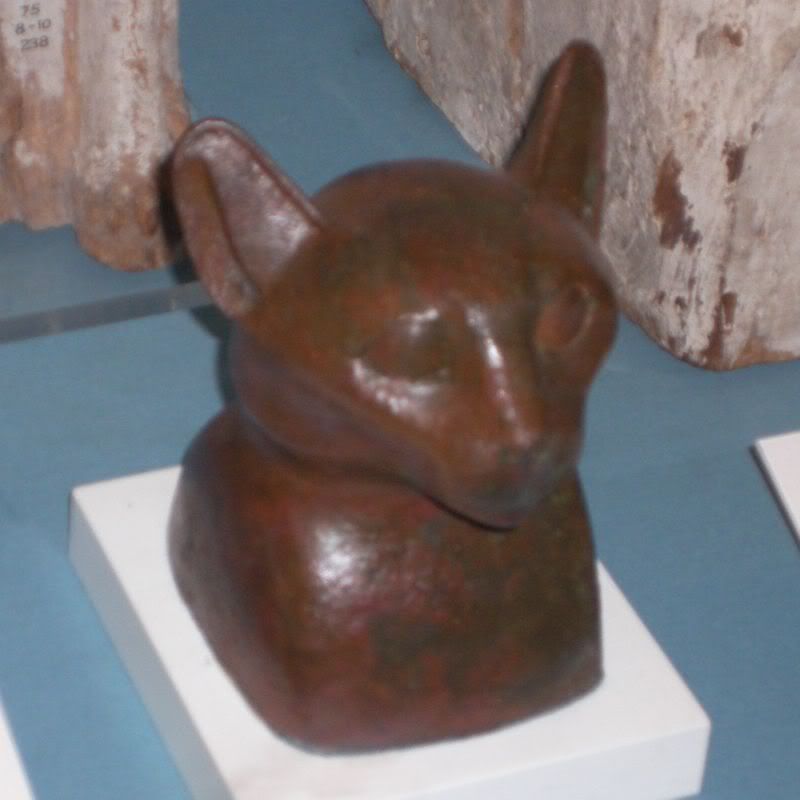
[Above - A bronze mask for a mummified cat from the Ptolemaic Period. At the British Museum, London, England.]
Another reason for cats being mummified in ancient Egypt was as an offering to a deity. All animals, including cats, were not considered to be gods themselves, only that gods could sometimes choose to show themselves to humans through the bodies of animals; examples of deities sometimes choosing a feline guise include Aset (Isis), Hut-Hor (Hathor), and the god Maahes, who was considered the son of the cat-headed goddess Bastet in Lower Egypt, but also he was thought of as the son of the lioness-headed goddess Sekhmet in Upper Egypt. Certain animals became symbolic of particular gods whom possessed similar characteristics to their chosen animal, and one of the most popular type of animal to become associated with the gods was the feline. The idea of gods manifesting themselves as certain domestic animals developed wildly in the Egyptian Late Period, which led to - especially in Ptolemaic times - pilgrims leaving offerings of mummified animals to the gods, in hopes that their prayers would be answered. Because the offering of symbolic animals was so hugely popular during this time, cats became attached to temples and were bred in catteries to represent the feline deity associated with that temple, but in most cases the fate of these bred cats was not particularly good, as they were simply killed to be mummified and sold to pilgrims to offer to the deity. In keeping with the mummification methods of humans during this period, the outer appearance of the mummified cat was more important than what was going on inside the wrappings. X-rays of mummified cats have shown that these bred cats only lived to be a year old at the most - often only living for a few months - and were killed by twisting their necks or strangling them; this is revealed by the displaced vertebrae that show up in the X-rays. Evidence has even exposed that some of these cats were killed from a sharp blow to the head. Investigations into mummified votive cats have also shown that these mummified cats did not always contain a whole animal, as often limbs etcetera were missing, so it would seem that these mummies were put together rushed without much consideration to the potential buyers; it was a big money business, so it would have been far more important that the mummies were available in large quantities, rather than them needing to be expertly produced. Besides, so long as the outer wrappings resembled a cat in shape and style, none of the pilgrims would have been any wiser that everything was not present inside the mummy.
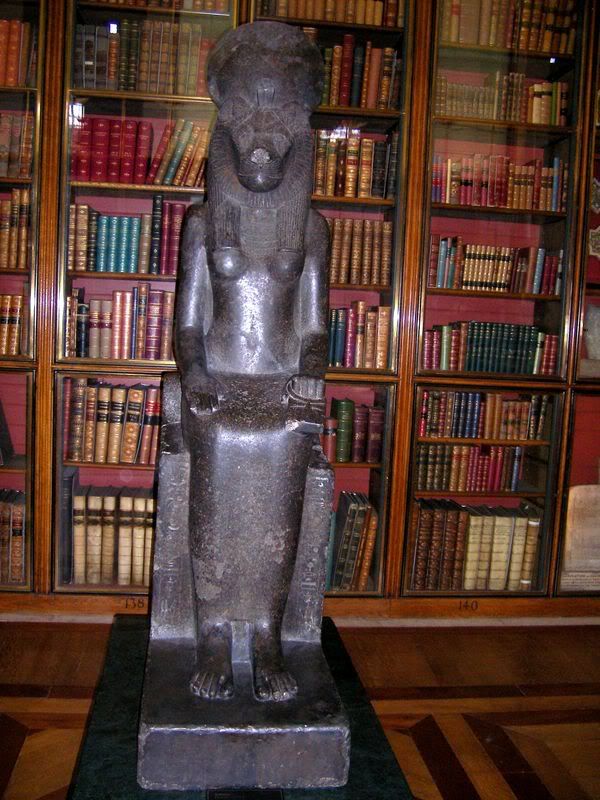
[Right - Statue of Sekhmet, 1370 BC. This is one of a possible seven-hundred and thirty such granite statues of Sekhmet erected by Amenhotep (III) at his mortuary temple. In half of these statues Sekhmet was rendered seated and in the other half she was shown standing; a pair, one seated and one standing, is believed to represent each day of the year. So far, almost six-hundred of these statues have been found. Photo taken at the British Museum, London, England.]
Felines were very prominent in Egyptian religion, with many mentions of felines in religious texts and lots of different deities taking the form of various felines at one time or another. Some examples of felines in texts, and gods depicted as felines, are noted here. Mafdet, the panther goddess (or possibly a cheetah or leopard), was mentioned in the Pyramid Texts as springing on the neck of the serpent. Her name meant "the runner" and she was prayed to for defence against snakebites and scorpion stings, so her role as protector of the pharaoh against the snakes of the Underworld in these texts fits in nicely with her characteristics. In the seventh hour of the Imyduat (The Book of that which is in the Underworld), a cat-headed being decapitates enemies before Usir (Osiris) who is protected by the snake, Mehen; more feline-headed deities appear in this text in hours one, two, four, and ten, and in the eleventh hour there are eight lion-headed aspects of the goddess Sekhmet. A cat-headed creature named Miuty is named in the Book of the Gates as one of the guardians to the eleventh gate that the sun-god must pass through; the gateway is called "Mysterious of Approaches," and Miuty holds a serpent sceptre in one hand and a was sceptre in the other. More feline deities, including Miuty, appear in the Enigmatic Book of the Underworld; a unique example can be found on the second shrine of Tutankhamun. In the Book of the Caverns a cat-headed god binds the enemies of the sun-god, and in the Litany of Ra texts a mummiform feline-headed deity is depicted as well as a seated cat as aspects of the sun-god. The god, Ra, is depicted as the great cat of Iunu (Heliopolis) in the texts known as The Book of Coming Forth by Day (more commonly known as The Book of the Dead) sitting beside the ished tree (same as the Greek Persea tree), whilst defeating the snake-demon, Apep (Apophis), by brandishing a knife. Feline-headed deities also appear in the line-up of forty-two judges in the weighing of the heart spell from The Book of Coming Forth by Day, as well as a double-headed guardian (a lion-headed goddess with a crocodile head emerging from the back of her neck), called Hetepethor, sometimes being present in these texts. In these examples, the cat always seems to be viewed in a positive light. Both the goddess, Neith, and the goddess, Tefnut, have a lioness-headed aspect, as does Mut, whom had a sandstone seated cat statue dedicated to her at her precinct in the Karnak Temple; this was discovered in 1979 by the Brooklyn Museum Expedition. But by far the most popular feline deities were Bastet, Sekhmet, and Pakhet. During dynasty twenty-three to twenty-four, the Libyan rulers brought the worship of Bastet to prominence by making Per-Bast (Bubastis) their royal city and building temples in her honour there. At this time Bastet grew from a local goddess to a state deity, and with that her depictions evolved from her being generally shown as a human goddess with the head of a cat, to her being mostly represented as a cat sitting on its haunches with its tail curled around its feet. Sometimes Bastet, when depicted as a cat-headed woman, was shown carrying a basket in which to hold her kittens; this represents her associations with motherhood and fertility. A cat cemetery was unearthed at Per Bast by Edouard Naville, which contained thousands of mummified cats, as well as possibly the ashes of cremated cats. The goddess Sekhmet was considered a more ferocious aspect of Bastet, but was worshipped in her own right. When Amenemhat (I) moved the capital from Waset (Thebes) to Itjtawy in the Fayoum, the cult centre of Sekhmet moved there as well, and in Taremu (Leontopolis) tamed lions were kept in temples dedicated to the goddess. Sekhmet was depicted in artwork as a lion or lion-headed woman, and had cat cemeteries dedicated to herself and Bastet at Saqqara. Pakhet, another lion-headed goddess, was probably seen as a mixture of Bastet and Sekhmet; her temperament being somewhere in between the tender traits of Bastet and the wild nature of Sekhmet. Not only was Pakhet depicted as a lion-headed woman, but also as a feline killing snakes with her claws. Pakhet had two temples dedicated to her at Speos Artemidos ("Cave of Artemis" in Greek) and has catacombs containing mummified cats devoted to her.
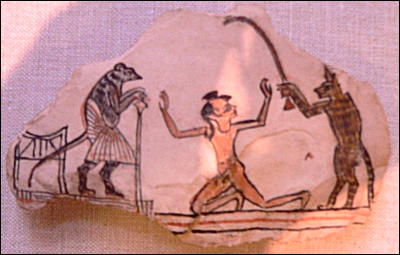
[Above - New Kingdom, nineteenth or twentieth dynasty, Limestone Ostracan from the Oriental Institute, Chicago, Illinois. Pigment on recto depicts a man being judged by a mouse and punished by a cat; the drawing was first sketched in red ink, then was outlined in black ink, and finally coloured in. On the verso is the inscription "Cat and mouse bring the bad boy to court" in hieratics. Photo supplied by Bob Manske.]
Not only were felines mentioned in religious texts in ancient Egypt, but they also found themselves in other texts and artwork as well. An ancient Egyptian text containing dream interpretation describes the outcome of seeing a large cat in one's dreams; this is referred to as a good omen because it is said to mean that a large harvest will come to the dreamer. Depictions of cats are also found in humorous scenes on ostraca and papyrus; these often include role reversal type situations. In one such example, ducks are being herded by a cat that walks upright on its hind paws. One ostracan shows a lady mouse or rat being attended by two cats; one cat does the lady's hair and the other one looks after the wine supply with a kitten. In another scene a rat is being presented with a roasted goose by a standing cat that is also fanning the rat. Another example, dating to 1150 BC and currently being housed at the Oriental Institute in Chicago, Illinois, shows a rat dressed up in royal garb (pleated kilt) whilst leaning on a staff in front of a throne. This rat oversees the punishment of a human boy; the punishment being dealt out by a cat standing on his rear legs whilst brandishing a stick at the man. These informal representations of cats are so comical due to the natural proud attitude of the feline, which the ancient Egyptian artists tapped into perfectly. Other animals were used in amusing depictions, too, including animals playing musical instruments in the satirical section of the Erotic Turin Papyrus. It seems that this was the ideal way for them to display their idea of the topsy-turvy world they lived in. Cats are featured in every kind of setting; not only the comical scenes of cats ruling over the land like a king, cats waiting on mice, and mice mocking cats, but also a cat laid with her young, kittens in baskets, and cats eating, strolling, and at rest. During the Late Period, cats were even shown nursing the pharaoh. Strangely, though, cats are not depicted sleeping, even though cats famously spend much of their life dozing; on average, about fourteen hours per day.
In religious ceremonies priests often wore the skin of the cheetah or leopard as a robe; these skins would have been imported from Nubia. Barring this point, cats did not have any physical produce to equip the Egyptians with, instead they were usually seen as protective animals, so objects were often made in the shape of cats, including jewellery, amulets, and statues, or like in the case of magical wands, simply have cats depicted on them. Two gold spacer bars from a bracelet exist, now in the British Museum, that may have belonged to Queen Sobekemsaf, 1650 BC, and depict three cats on each spacer bar. Many feline-related statues exist, too, either of feline-headed deities, or of fully formed cats. One such statue sits in the British Museum today, named the Gayer-Anderson Cat after the person that donated it to the museum (Robert Grenville "John" Gayer-Anderson, who was an army Major); John Gayer-Anderson also donated a gold and carnelian finger-ring with a cat figure on it from Egypt. The overall statue is forty-two centimetres tall, sitting on its rear legs with its tail laid along the ground by its right legs and its head tilted slightly downwards, it is a true masterpiece in bronze. The eye cavities of the statue now remain empty, but once likely had some form of precious material (stone or metal) inside to resemble the eyes. Incisions and raised lines in the piece mark the eye-lines, whiskers, nose, and ears on the face to give a more life-like appearance. The markings around the eyes and those that extend from the centre of the eyes towards the ears are probably there to denote the natural markings of the species of cat that the statue was crafted to resemble, as does the raised scarab sitting on the cat's forehead. It was possibly noticed in ancient times that the hair inside this species of cat's ears looked very much like the feather that they used in their hieroglyphic system, as the inner ears were made to look like feathers in this statue; the feather resembled truth and justice in ancient Egypt. Cat statues like this one are often depicted wearing earrings, nose-rings, necklaces, and collars. In the Gayer-Anderson Cat, the four-tiered collar is incised onto the statue and a uadjet eye pectoral made from silver was inserted into the piece. Both ears are pierced at the bottom of the lobe to suspend an earring from each; a third ring hangs from the nose, pierced through the septum. The rings, not including the wire that they are hanging from, is all ancient, but they are not the original rings that belonged to this statue. The cat's body shape is all rendered beautifully in this statue; with shoulder blades, ribcage, spine, and legs all in proportion. The cat's claws are featured well in the sculpture, too, and you can see barred markings at the end of the tail which is attained with three raised bands at the tail's tip. Possibly made as a votive statue, like in the case of the specially mummified cats discussed earlier, to offer to a deity. Many people consider the Gayer-Anderson Cat the best of all the ancient Egyptian bronze cat statues, and it certainly is well loved by the visitors of the British Museum.
Even after the age of the pharaohs the cat was highly thought of. A favoured cat of the Prophet Muhammad called Muezza was said to be loved so much by the Prophet, that one day when Muhammad was called to prayer and found Muezza asleep in the folds of his robes, rather than wake the cat, he chose to cut the sleeve off his robe so he could leave Muezza undisturbed. The reason that Muhammad loved cats so much was that he was once said to be saved by one. Apparently, a snake was trying to bite Muhammad, but just in time a pious man walked by with a cat in his bag, and seeing the Prophet in trouble he let his cat out so that it attacked and killed the snake. Prophet Mohammad stroked his feline-saviour across her back and touched her head in thanks; because he touched the cat's back, it is said that cats now never fall on their backs and always land on their feet, and touching the cat's head is said to have left the finger marks of the Prophet on all cats' heads, which is why cats always have four stripes on their head. One story even tells of a cat giving birth to her kittens on Prophet Muhammad's coat. A saying which has been attributed to the Prophet is, "Love of cats is part of the faith."

[Above - Arabic word for cat: qitta.]
* Special thanks to Kat Newkirk for advising me, and providing me, with ideal texts to read, which enabled me to write this article on cats in ancient Egypt.
** Extra thanks goes to John V. DeWerd and Bob Manske for letting me use their beautiful photographs.
Thursday 10 July 2008
Ancient Egyptian Cats in the Modern World
Some cats of the modern world are supposed to have direct relationship to the cats of ancient Egypt. Firstly, there is the Chausie. Chausies are a cross between the felis chaus and a domestic cat, usually the Abyssinian. The felis chaus is known as the Jungle Cat, Reed Cat, or Swamp Cat, and could be found throughout Egypt (as well as in parts of Asia). Felis chaus began being crossed in the nineteen-sixties and seventies with the domestic cat to create a tame, homely cat with the wild look and characteristics. Only registered with The International Cat Association since March of 1995, the Chausie is quite a new recognised breed. The size and shape of the Chausie correspond greatly with the felis chaus that it originates from, and it is very reminiscent of the cats depicted in ancient Egyptian artwork, especially those cats that are shown plain tan-coloured or solid black. The goddess Bastet as a cat is often thought to be the felis chaus; the mummified remains of these cats have been discovered in Egypt at Beni Hasan. There are three colours of Chausie that are recognised in this short to medium hair breed: golden, black, and silver-tipped melanistic, which are also the naturally occurring colours of the felis chaus. Chausie kittens are commonly spotted or striped, but as they mature the markings fade, leaving a ticked coat with barring only visible on the legs and tail. An adult Chausie can be around fourteen to eighteen inches tall (to the shoulders), and they are slender, long cats with slightly longer back legs than the front. Their tail is preferred to be of three-quarter length, which means their body is almost twice as long as their tail. They can jump vertically to around six feet on their long legs with petit feet; an attribute taken from their wild-cat ancestor, the felis chaus, who can leap eight feet into the air to catch flying birds. Taking two to three years to attain their full size, males can be around twenty-five pounds in weight, with the females being somewhat smaller and lighter. The breed is especially intelligent, affectionate, loyal, and active, and bond well with other pets in the household; sometimes being regarded as very dog-like in character themselves. An elegant and graceful cat with large mobile ears which can be tufted, slightly flattened almond-shaped eyes that are usually yellow or golden, a nose that is broad between the eyes, and full whisker-pads, strong chin, and a muscular neck, makes the Chausie a beautiful breed. Other cats that are known from ancient Egypt, besides the felis chaus, are the felis serval (now bred with domestic cats to become the Savannah) and the felis silvestris lybica (African Wildcat).
As previously stated, in breeding the Chausie, the felis chaus was bred with the Abyssinian. The Abyssinian was used mainly due to the fact that it most closely resembles the felis chaus and has the features that compliment the breed very well. The actual origins of the Abyssinian are not known with any certainty because it started being bred over one-hundred years ago in Britain when records of these things were not kept, though there is one interesting story that says that the first Abyssinian, called Zula, was brought to Britain from Abyssinia (Eritrea), Ethiopia, in 1868 by the wife of an army captain, Mrs. Barrett-Lennard; Abyssinians are thought to be Zula’s descendants after she herself was bred with an English tabby. Many products, including live animals, were imported from Ethiopia into Egypt during ancient times, so this could mean that the Abyssinian cat does have links to ancient Egypt; more than just simply looking like the cats in their artwork, they could actually be them. Since the Abyssinian began being bred in the United States of America, one or more Abyssinians may have been added to the gene pool there from Libya. The Abyssinian Cat Club, in association with the Governing Council of the Cat Fancy, was founded in 1929 to promote the breeding of the Abyssinian, and they have grown in popularity ever since; often also being used in many other breeding programs as a cross, like in the case of the Chausie. The body of the Abyssinian is well-balanced and muscular, and their posture and poise is very regal. This breed now has many coat colours that are officially recognised, but one of the earliest known Abyssinians was possibly silver, and now the more common are of usual (a base of ruddy orange with an overall appearance of being a golden brown colour), sorrel (cinnamon), or blue. Whatever colour the Abyssinian is, they all have ticked coats which gives them a feral look; a line of ticking should extend from the back of their head and travel along the spine and down the tail to terminate in a solid colour (same as the ticking colour that runs down their back) at the end of the tail. Ticking lines should also be present from the outer edge of the eyes extending towards the ears and from the inner side of the eyes to the top of the head. No barring, necklet, or markings should be seen on the Abyssinian, except for possibly slight broken necklets or bars. Kittens of this breed are born with dark coats that gradually lighten as they get older; usually taking many months to attain their final colouring. These cats are of a medium size, adults weighing between seven and twelve pounds, with straight backs from their shoulders to rump, long slender legs, small oval-shaped feet, and a tapering tail. Abyssinians have well-cupped ears that are often tufted and are prickly on the inner edge, rounded almond-shaped eyes in amber, gold, copper, or hazel, and an elegant neck. An Abyssinian's nose and chin should form a straight line when they are viewed in profile, and their moderately-pointed ears should continue the planes of their head. Though Abyssinians are fairly quiet cats, they are also extremely demanding, and will make sure they receive any attention they feel is deserved to them. They are an athletic breed, too, so will cross all obstacles in their path to reach any goal. Above all, the Abyssinian is a friendly breed of cat which is very people orientated and has an unusual - yet adorable - habit of head-butting their owners, and they are so outgoing that they rarely become lap cats.
Long-haired Abyssinians occassionally appear in litters from Abyssinian parents, and in 1963 the first long-haired Abyssinian was entered into a cat show. A judge, Ken McGill, at the show asked the owner for one to breed from; he eventually produced the first official long-haired Abyssinian, which are now known as Somalis. Like the Abyssinian, the Somali has a ticked coat comprising of between three and twelve bands of colour on each hair, with the bands darker at the tip and lighter at the root; this gives the coat a shimmer as the light bounces off it. They appear in the same colours as their Abyssinian ancestors, but with their long coats giving them a ruff around the neck and a bushy tail, Somalis are often called "fox cats". Somalis are active and natural hunters that love the outdoors, so if they are to be kept as an indoor pet they need to be introduced to this lifestyle as kittens, or be permitted to outdoor enclosed areas or walked on a harness to give them their freedom.

[Left - Sherif, a bronze Egyptian Mau kitten that was either abandoned or orphaned and is currently being looked after by the Egyptian Mau Rescue Organisation until he gets adopted. He was born in March 2008. As of the 25th September 2008, Sherif is currently on hold, waiting to go to his new home in Canada, once a pet escort is found.]
Last but not least, in discovering the cats of ancient Egypt, are the Egyptian Mau; a subspecies of the African Wildcat, felis silvestris lybica. The Mau can still be seen in Egypt today, but they are wild cats that hunt in dust bins for food with little veterinary care, and are thought of as little more than pests; often being poisoned. This is a far cry from how the Egyptian Mau was regarded in ancient Egypt or indeed how they are considered throughout the rest of the world in modern times. The Romans are likely the ones responsible for taking Maus from Egypt to Italy - and possibly to other places in Europe and the Near East - not long after the Roman rule on Egypt, as Roman mosaics and murals depict Egyptian-looking cats. This was probably due to the Romans bringing the advent of Christianity, so sacred animals of Egypt, like the cat, were not restricted to be taken from Egyptian land, therefore the Romans were free to take these exotic animals away with them for pets or in use of barter and exchange. The fact that cats were often taken aboard ships during these times to help control the vermin, no doubt helped in the spread of the Egyptian cat, too. In the early 1950’s an exiled Russian princess called Nathalie Troubetskoy was presented with a female kitten that was silver-spotted by a young boy that had gotten it from a diplomat working in an embassy of the Middle East. Finding this kitten very fascinating, the princess sought to find out more about its origins. Her research showed her that it was an Egyptian Mau, and she decided to promote the breed in America in hopes of saving the Mau from extinction. She took with her to the USA, in 1956, three Maus (two females and one male) and set up a cattery to breed them. Once the Cat Fancier’s Association recognised the breed and gave it championship status, other Maus were brought into the USA by various breeders to widen the gene pool. Outcrosses may have been used in the very early days to establish this breed, though no definitive proof remains of this, but the breed still retains all its looks and characteristics of the wild Maus that still live in Egypt to this day. No outcrosses are permitted now. The Egyptian Mau was first officially introduced to the United Kingdom by Melissa Bateson in 1998 when she brought home five Maus (three queens, one stud, and one neuter) after spending two years working in the USA. Now there are a handful of catteries throughout the UK that breed the Mau for showing and as pets. When the ancient Egyptian sun-god, Ra, is depicted in artwork as a cat, he is usually thought to be the Egyptian Mau. The only real physical difference between the spotted cats depicted in ancient Egyptian artwork and the modern Mau are the eyes; ancient renderings show wild-looking eyes, whereas the Mau of the modern era have large rounded eyes. Maus are the only naturally spotted small cat breed, and the colours that this short-haired breed can come in are silver (silver ground colour with charcoal markings), bronze (bronze ground colour with dark brown markings), smoke (charcoal ground colour with jet black markings), and can even come in blacks or blues, though these two colours are not allowed to be shown. The underside of their body is paler than the outerside. This breed is medium-sized - at around ten to fourteen pounds for males and six to ten pounds for females on average - and very graceful with a cheetah-like walk; their body is medium long with prominent shoulder blades and a loose skin flap extending from the flank to the hind-leg knee which enables them to jump around seven feet high fluently and run over thirty miles per hour. The Maus high movablity and speed is also down to them having longer back legs than the front, which can give the impression that they are walking on tippy-toes. Random spotting covers their back and sides, and they also have a spotted waistcoat on their underside. Their legs have a transition between stripes and spots, they have dainty feet, and a long, tapering tail barred down its length with a dark coloured tip. The face is a rounded wedge and they have large alert ears which are moderately pointed, set far apart on the head, and continue the planes of the head; the inner ears are a shell pink colour and ears can be tufted. Maus have large almond-shaped eyes that slant towards the ears and are gooseberry-green in colour; an amber cast to the eyes is permitted in kittens. Facial markings include a scarab on the forehead with a 'M' marking which creates the characteristic worried or concerned expression that the Mau is known for. In artwork from ancient Egypt, the cat is often shown with a scarab marking on its forehead, so it is highly likely that the ancient Egyptians also noticed how much the markings on their cats' foreheads looked like their sacred scarab. Interestingly, later Italian legend has it that the 'M' mark on the Mau's and Tabby's head is the mark of the Virgin Mary. It is said that when the baby Jesus was in the manger, he could only be soothed by a Mau cat, so Mary blessed the cat and created the 'M' mark on its head. A mascara line extends from each of the outer corners of the eyes to the sides of the face and a second set of mascara lines go across the cheeks; when you look at the make-up style of the ancient Egyptians it makes one wonder if the Mau’s mascara lines were where the original idea came from for people’s cosmetic lines. The Egyptian Mau should also have one or more broken necklaces. In a well cared for indoor environment, a Mau can live to be around fifteen years old. Maus are very intelligent and active; learning to retrieve or walk on a harness with not much trouble. They also learn very quickly how to get what they want from their owners and can be extremely stubborn and especially possessive with their toys. The Mau will bond well with its adoptive family, but may be somewhat shy of strangers. An amusing trait of this breed is when they start batting objects they find strange and deserves their investigation with their front paws really quickly. Maus can often become shoulder riders. Very vocal is this breed; rarely will you not hear your Mau chirping, chortling, meowing, and playfully growling during their waking hours!

[Right - Aaron, a bronze Egyptian Mau Shirazi that is currently awaiting adoption at the Egyptian Mau Rescue Organisation with his littermate, Andy. His estimated date of birth is June 2006.]
Roaming the streets of Egypt can also be found the Shirazi Mau, which is a long-haired breed of Mau. They possibly originate from the Egyptian Persian period, when the Egyptian Mau got bred with Persian cats. Shirazis are not yet a recognised breed, but they are undoubtedly a very ancient breed. The Shirazi is very similar to the regular Mau, except for the hair length, which makes their tails appear more bushy. The hair of the Shirazi flows smoothly through the fingertips.
As previously stated, in breeding the Chausie, the felis chaus was bred with the Abyssinian. The Abyssinian was used mainly due to the fact that it most closely resembles the felis chaus and has the features that compliment the breed very well. The actual origins of the Abyssinian are not known with any certainty because it started being bred over one-hundred years ago in Britain when records of these things were not kept, though there is one interesting story that says that the first Abyssinian, called Zula, was brought to Britain from Abyssinia (Eritrea), Ethiopia, in 1868 by the wife of an army captain, Mrs. Barrett-Lennard; Abyssinians are thought to be Zula’s descendants after she herself was bred with an English tabby. Many products, including live animals, were imported from Ethiopia into Egypt during ancient times, so this could mean that the Abyssinian cat does have links to ancient Egypt; more than just simply looking like the cats in their artwork, they could actually be them. Since the Abyssinian began being bred in the United States of America, one or more Abyssinians may have been added to the gene pool there from Libya. The Abyssinian Cat Club, in association with the Governing Council of the Cat Fancy, was founded in 1929 to promote the breeding of the Abyssinian, and they have grown in popularity ever since; often also being used in many other breeding programs as a cross, like in the case of the Chausie. The body of the Abyssinian is well-balanced and muscular, and their posture and poise is very regal. This breed now has many coat colours that are officially recognised, but one of the earliest known Abyssinians was possibly silver, and now the more common are of usual (a base of ruddy orange with an overall appearance of being a golden brown colour), sorrel (cinnamon), or blue. Whatever colour the Abyssinian is, they all have ticked coats which gives them a feral look; a line of ticking should extend from the back of their head and travel along the spine and down the tail to terminate in a solid colour (same as the ticking colour that runs down their back) at the end of the tail. Ticking lines should also be present from the outer edge of the eyes extending towards the ears and from the inner side of the eyes to the top of the head. No barring, necklet, or markings should be seen on the Abyssinian, except for possibly slight broken necklets or bars. Kittens of this breed are born with dark coats that gradually lighten as they get older; usually taking many months to attain their final colouring. These cats are of a medium size, adults weighing between seven and twelve pounds, with straight backs from their shoulders to rump, long slender legs, small oval-shaped feet, and a tapering tail. Abyssinians have well-cupped ears that are often tufted and are prickly on the inner edge, rounded almond-shaped eyes in amber, gold, copper, or hazel, and an elegant neck. An Abyssinian's nose and chin should form a straight line when they are viewed in profile, and their moderately-pointed ears should continue the planes of their head. Though Abyssinians are fairly quiet cats, they are also extremely demanding, and will make sure they receive any attention they feel is deserved to them. They are an athletic breed, too, so will cross all obstacles in their path to reach any goal. Above all, the Abyssinian is a friendly breed of cat which is very people orientated and has an unusual - yet adorable - habit of head-butting their owners, and they are so outgoing that they rarely become lap cats.
Long-haired Abyssinians occassionally appear in litters from Abyssinian parents, and in 1963 the first long-haired Abyssinian was entered into a cat show. A judge, Ken McGill, at the show asked the owner for one to breed from; he eventually produced the first official long-haired Abyssinian, which are now known as Somalis. Like the Abyssinian, the Somali has a ticked coat comprising of between three and twelve bands of colour on each hair, with the bands darker at the tip and lighter at the root; this gives the coat a shimmer as the light bounces off it. They appear in the same colours as their Abyssinian ancestors, but with their long coats giving them a ruff around the neck and a bushy tail, Somalis are often called "fox cats". Somalis are active and natural hunters that love the outdoors, so if they are to be kept as an indoor pet they need to be introduced to this lifestyle as kittens, or be permitted to outdoor enclosed areas or walked on a harness to give them their freedom.

[Left - Sherif, a bronze Egyptian Mau kitten that was either abandoned or orphaned and is currently being looked after by the Egyptian Mau Rescue Organisation until he gets adopted. He was born in March 2008. As of the 25th September 2008, Sherif is currently on hold, waiting to go to his new home in Canada, once a pet escort is found.]
Last but not least, in discovering the cats of ancient Egypt, are the Egyptian Mau; a subspecies of the African Wildcat, felis silvestris lybica. The Mau can still be seen in Egypt today, but they are wild cats that hunt in dust bins for food with little veterinary care, and are thought of as little more than pests; often being poisoned. This is a far cry from how the Egyptian Mau was regarded in ancient Egypt or indeed how they are considered throughout the rest of the world in modern times. The Romans are likely the ones responsible for taking Maus from Egypt to Italy - and possibly to other places in Europe and the Near East - not long after the Roman rule on Egypt, as Roman mosaics and murals depict Egyptian-looking cats. This was probably due to the Romans bringing the advent of Christianity, so sacred animals of Egypt, like the cat, were not restricted to be taken from Egyptian land, therefore the Romans were free to take these exotic animals away with them for pets or in use of barter and exchange. The fact that cats were often taken aboard ships during these times to help control the vermin, no doubt helped in the spread of the Egyptian cat, too. In the early 1950’s an exiled Russian princess called Nathalie Troubetskoy was presented with a female kitten that was silver-spotted by a young boy that had gotten it from a diplomat working in an embassy of the Middle East. Finding this kitten very fascinating, the princess sought to find out more about its origins. Her research showed her that it was an Egyptian Mau, and she decided to promote the breed in America in hopes of saving the Mau from extinction. She took with her to the USA, in 1956, three Maus (two females and one male) and set up a cattery to breed them. Once the Cat Fancier’s Association recognised the breed and gave it championship status, other Maus were brought into the USA by various breeders to widen the gene pool. Outcrosses may have been used in the very early days to establish this breed, though no definitive proof remains of this, but the breed still retains all its looks and characteristics of the wild Maus that still live in Egypt to this day. No outcrosses are permitted now. The Egyptian Mau was first officially introduced to the United Kingdom by Melissa Bateson in 1998 when she brought home five Maus (three queens, one stud, and one neuter) after spending two years working in the USA. Now there are a handful of catteries throughout the UK that breed the Mau for showing and as pets. When the ancient Egyptian sun-god, Ra, is depicted in artwork as a cat, he is usually thought to be the Egyptian Mau. The only real physical difference between the spotted cats depicted in ancient Egyptian artwork and the modern Mau are the eyes; ancient renderings show wild-looking eyes, whereas the Mau of the modern era have large rounded eyes. Maus are the only naturally spotted small cat breed, and the colours that this short-haired breed can come in are silver (silver ground colour with charcoal markings), bronze (bronze ground colour with dark brown markings), smoke (charcoal ground colour with jet black markings), and can even come in blacks or blues, though these two colours are not allowed to be shown. The underside of their body is paler than the outerside. This breed is medium-sized - at around ten to fourteen pounds for males and six to ten pounds for females on average - and very graceful with a cheetah-like walk; their body is medium long with prominent shoulder blades and a loose skin flap extending from the flank to the hind-leg knee which enables them to jump around seven feet high fluently and run over thirty miles per hour. The Maus high movablity and speed is also down to them having longer back legs than the front, which can give the impression that they are walking on tippy-toes. Random spotting covers their back and sides, and they also have a spotted waistcoat on their underside. Their legs have a transition between stripes and spots, they have dainty feet, and a long, tapering tail barred down its length with a dark coloured tip. The face is a rounded wedge and they have large alert ears which are moderately pointed, set far apart on the head, and continue the planes of the head; the inner ears are a shell pink colour and ears can be tufted. Maus have large almond-shaped eyes that slant towards the ears and are gooseberry-green in colour; an amber cast to the eyes is permitted in kittens. Facial markings include a scarab on the forehead with a 'M' marking which creates the characteristic worried or concerned expression that the Mau is known for. In artwork from ancient Egypt, the cat is often shown with a scarab marking on its forehead, so it is highly likely that the ancient Egyptians also noticed how much the markings on their cats' foreheads looked like their sacred scarab. Interestingly, later Italian legend has it that the 'M' mark on the Mau's and Tabby's head is the mark of the Virgin Mary. It is said that when the baby Jesus was in the manger, he could only be soothed by a Mau cat, so Mary blessed the cat and created the 'M' mark on its head. A mascara line extends from each of the outer corners of the eyes to the sides of the face and a second set of mascara lines go across the cheeks; when you look at the make-up style of the ancient Egyptians it makes one wonder if the Mau’s mascara lines were where the original idea came from for people’s cosmetic lines. The Egyptian Mau should also have one or more broken necklaces. In a well cared for indoor environment, a Mau can live to be around fifteen years old. Maus are very intelligent and active; learning to retrieve or walk on a harness with not much trouble. They also learn very quickly how to get what they want from their owners and can be extremely stubborn and especially possessive with their toys. The Mau will bond well with its adoptive family, but may be somewhat shy of strangers. An amusing trait of this breed is when they start batting objects they find strange and deserves their investigation with their front paws really quickly. Maus can often become shoulder riders. Very vocal is this breed; rarely will you not hear your Mau chirping, chortling, meowing, and playfully growling during their waking hours!

[Right - Aaron, a bronze Egyptian Mau Shirazi that is currently awaiting adoption at the Egyptian Mau Rescue Organisation with his littermate, Andy. His estimated date of birth is June 2006.]
Roaming the streets of Egypt can also be found the Shirazi Mau, which is a long-haired breed of Mau. They possibly originate from the Egyptian Persian period, when the Egyptian Mau got bred with Persian cats. Shirazis are not yet a recognised breed, but they are undoubtedly a very ancient breed. The Shirazi is very similar to the regular Mau, except for the hair length, which makes their tails appear more bushy. The hair of the Shirazi flows smoothly through the fingertips.
Friday 4 July 2008
Aalspotz Kleopatra "Qetesh"
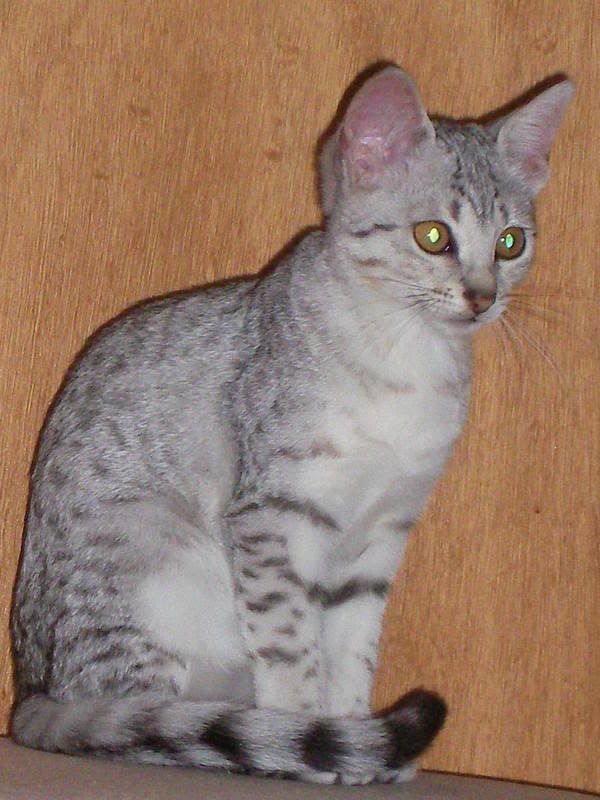
[Right - Qetesh at around sixteen weeks old posing for the camera.]
When I first saw the modern Egyptian Mau in the flesh - or more accurately, the fur - I was astounded as to how affectionate and lively the breed are. Obviously, I had read a lot about the breed before deciding to welcome one into my family and comitting myself to such a responsibility, but I thought they would be very shy amongst strangers in their midst, but this breed appeared to be extremely playful and literally throw themselves at their guests! The Maus I visited were a new litter of kittens at the Aalspotz cattery in West Cowick, which I visited in April 2008. I had the intention of asking for the only boy of the litter, as I had been thinking of owning a male Mau for a while, but a beautiful little dark coloured girl Mau changed my mind, as she spent much of the time I was there clambering up onto my lap to be petted. I was told by the breeder that the reason she was being sold as a pet instead of being a show cat or for breeding was due to the angle to which her ears are set; rather than following the planes of the head her ears were more upright, which gives a more startled or alert look to the face, which is something she inherits from her mother. This I was not concerned about, and I could not deny that she had the most gorgeous markings and an adorable personality. It was so sweet that the little girl had chosen me to be her new owner, so I gladly agreed to have her.
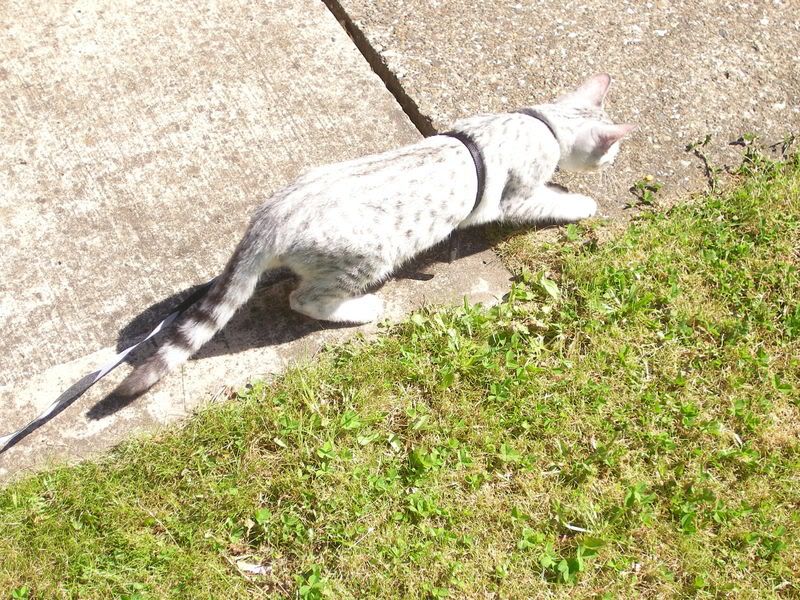
[Above - Qetesh at around nineteen weeks old trying out walking on her harness.]
The Mau kitten was brought to me from the breeder on the 28th May 2008. Officially registered as Aalspotz Kleopatra, but now affectionately called Qetesh, she has quickly become a very important part of my life. She was born on the 12th February 2008 as part of a litter of four. I do not know any of the registered names of her sisters and brother, but their given names from their new owners, I believe, are Maisy, Sparkle, and Albert. Qetesh's sire and dam are both now at the Aalspotz cattery: Pollystar Arethusa "Ari" (born of Bacamamdit's Abydos and Santillo Tameri) and Chantina Esmeralda "Ellie" (born of Emaus Opening Gambit of Mautrix and Newkingdom Aida). The Great, Great Grandmother of Qetesh via both her sire and her dam is called J's Iris Qetesh of Newkingdom, born on the 4th May 1997 and responsible for the first Mau kittens to be born in the UK, which makes my Qetesh's given name all the more special, as she is named after one of her own ancestors. The name Qetesh (written as Kadesh by some) in ancient Egyptian means "The Holy One" and comes from a Canaanite goddess of love and beauty that was later adopted into the ancient Egyptian religion and associated with Hut-hor (Hathor). The goddess Qetesh was often depicted naked standing on the back of a lion holding snakes in one of her hands and lotus flowers in her other hand, representing the penis and vulva respectively. Even her registered name, Kleopatra, has Egyptian connections, as there were a few queens called Kleopatra (or Cleopatra) during the Ptolemaic dynasty, when the Greeks ruled Egypt; most notably Kleopatra VII Philopator, who ruled Egypt in her own right.
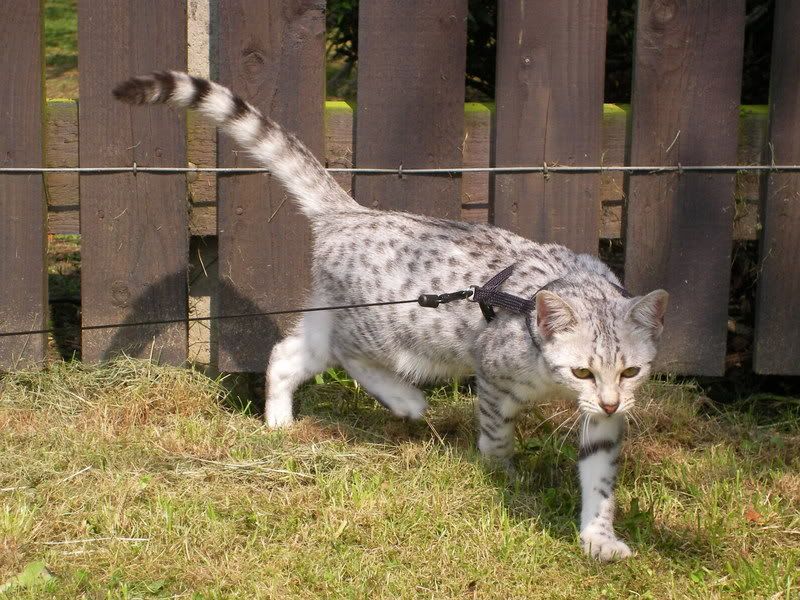
[Above - Qetesh at twenty-three and a half weeks old prowling around the garden looking for bugs to chase. She has even begun eyeing up the birds that fly overhead as if she is about to leap up out of her harness and grab one from mid-flight.]
Diary
25th July 2008
Having now been living with me for nearly two months, Qetesh’s personality and characteristics are much more apparent. She loves interaction with her adoptive family, enjoying spending a long time sitting on someone’s lap to be stroked, being groomed, or just perching herself on your shoulder for a ride around. When she is not lounging around being petted, she is off playing one of various hunting and stalking games: chasing around a laser pointer or hunting for her catnip fish or rattle on fishing rods. Some of her favourite toys include a catnip leopard-print mouse, rabbit feet, and coloured ping-pong balls. Within the first couple of weeks of her being here she introduced us to one of her more frightening games, that of Hide and Seek: realising that all of a sudden your kitten has disappeared without there being any doors or windows open is quite worrying, only to find her appear from nowhere twenty minutes later as if nothing had happened. She has attempted playing the same game once or twice since, but it has never had the same impact as it did the first. Qetesh definitely loves the outdoors, enjoying her long walks out on her harness twice a week very much. When she is not out for walks - or runs - and not out playing in the garden, she is sat on any available window sill to gaze out longingly at the passing dogs, cats, birds, and bugs. A few of her more strange qualities are scaring her reflected self through mirrors (in the dark she will arch her back and try staring herself out whilst walking towards her reflection menacingly), tearing through the house at eleven PM every night, and her weird passion for water. Her odd liking for water means that I get very few shower time and wash time in peace, as I always have a little furry spectator. Though she will never actually submerge herself in any water, she enjoys splashing about and being splashed. Besides batting my toothbrush with her forepaws, playing with the plug, or drinking from the shower floor, basin, or running tap, I have now begun to be blessed with seeing the characteristic Mau worried look whenever brushing my teeth or washing my hair; these two activities appear to be hugely fascinating to her. The worried or concerned look I never saw in her features in the first month or so that she was here, but in the last week or two, as her features and body has begun to mature, the worried look has become much more prominent, and when she looks you directly in the eye with this look it makes you feel very loved; this feature really cannot be done its justice from a photograph. Not only is Qetesh growing extremely well, but her spots over her back are now beginning to clear, so her markings are looking all the more beautiful. She is still keeping me in suspense as to the colour of her eyes, as they have not yet changed from amber, but I have vowed that once they have changed I will be getting some professional photographs of her. Qetesh now has some tarnishing (or what I like to refer to as tea-staining) around the muzzle, cheeks, and neck, but to me this just makes her features all the more attractive; it is a proud fact that everywhere Qetesh goes she always collects herself numerous admirers. She right away decided that my bed was much more comfortable than her own, so her bed has since been given away and she now spends her nights curled up on one of my blankets on my bed. Her behaviour has always been excellent; only ever resorting to slight naughtiness when she wants attention. One of her attention getters is pouncing on my laptop when I am working on it, and then laying down across the keyboard; she has actually crashed the computer on a few occasions by doing this. These past two months have been an utter joy, and I cannot wait for many more!
Diary
13th October 2008

[Left - Qetesh at around twenty-four weeks old posing for the camera.]
The past three months have been a huge journey for Qetesh. I shall start with which came first. On one very hot summer day I came home from shops and opened up the living room windows to let some fresh air in the house, as it had gotten incredibly stuffy. I was sitting opposite the windows the entire time, and I saw Qetesh walk along the window sill; fearing the worst, I was just about to get up and shut the windows so she could not get out, but she leapt up onto the television cabinet and I thought nothing more of it. Ten minutes later, however, I realised that I had not seen anything of her in a while so I went around the house looking for her. She was nowhere to be seen, so I called to her for a while, taking her favourite toys around with me, figuring that she was just playing her old game of Hide and Seek, but I did not even hear the slightest whimper from her. I thought I should probably check out in the street just in case she had gotten out of the window, even though I did not believe for one second that she had, so I went up the street checking every garden that I passed, to no avail. When I got back I checked in our garden down the side of the house, and there she was, playing on some freshly chopped down tree barks that she had been playing amongst the day before whilst out on her harness. As soon as she saw me she darted for the back door and waited to be let in. This was when I found out what a little monkey she really is, and realised what a mighty hand-full she is going to be over the coming years!
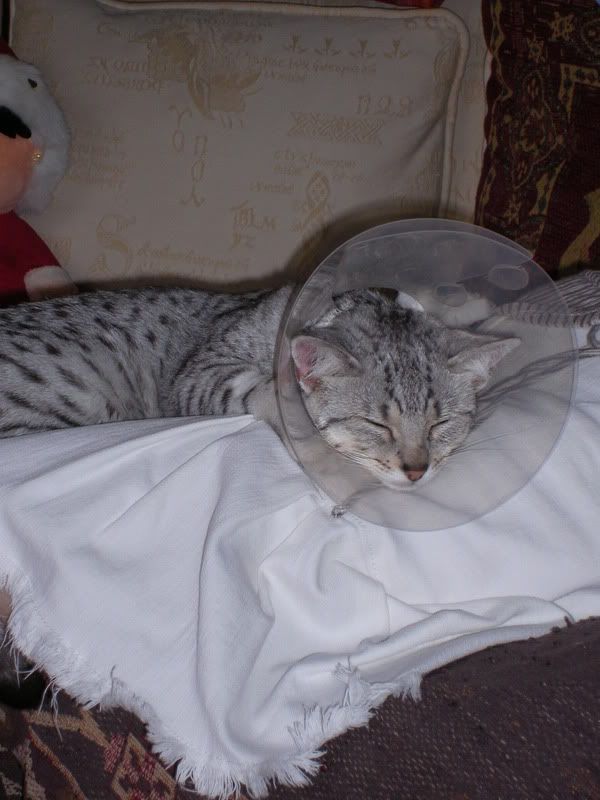
[Right - Qetesh at around twenty-seven weeks old after being spayed, wearing a Buster collar.]
Poor girl was suffering with some particularly bad teething problems for quite a lot of weeks, which made her a little ill for a time, as it put her off much of her food. On a recent trip to the vet, it was noted that her upper left canine tooth was missing and had been gone for more than a month. The vet said that he guessed that it was some kind of unfortunate birth defect, but that she will live fine without it, as she is an indoor cat; still another month on and that canine tooth has not made an appearance, so it would seem that the vet was correct in his assumption. Not long after she had started to recover from her teething, she was taken in to the vet to be spayed. Qetesh came home the same day of the operation completely full of beans until she realised that she had to wear a Buster collar. She was supposed to wear it at all times for two whole weeks, but after two days of seeing her miserable and bumping into things all the time, I just had her wear it during the night when she could not be constantly watched, so she soon perked up. She has been ill over the past month, too, due to a bacterial infection, which has seen her in and out of the vets for various test; it would seem like she is a walking advertisement for getting your pet insured. Trying to get herself stung by bees and wasps, and getting sardine bones stuck down her throat has been a constant reminder to how mischievous kittens will be.
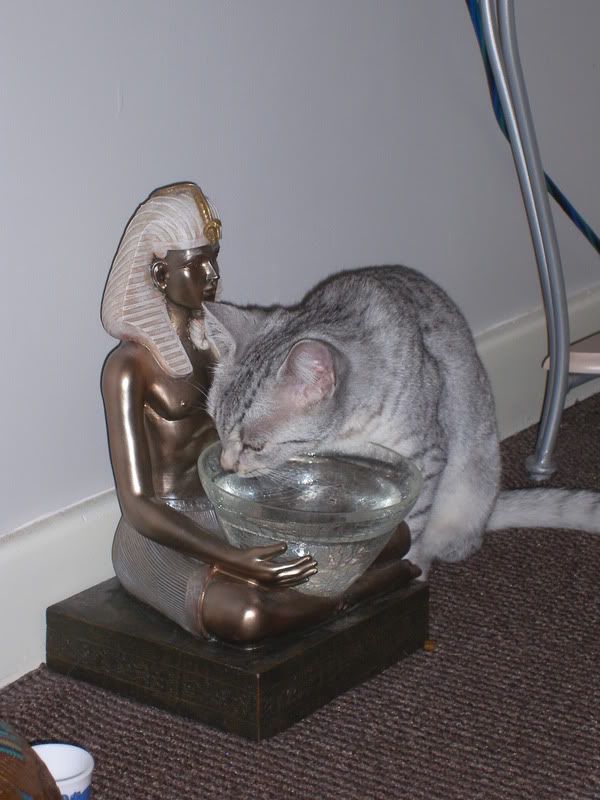
[Left - Qetesh at around thirty weeks old drinking from her water bowl.]
Qetesh still enjoys her walks on her harness and her playtime in the garden, where she often sits beneath a tree overhanging into the garden to watch the birds and to periodically moan at me for not letting her go chase them. Being trained to walk on a lead can be difficult for some cats, but Qetesh took to it easily, and there are some tips for doing this on Catnips cat sitting service, with a link leading to Qetesh’s story. She has a new habit of sitting by the front door after the postman has been to see if there is anything of interest for her, and she especially likes it when delivery men bring parcels around, even when it is not for her - which it often is; cat food, litter, trees, and toys - as she usually ends up with a nice big cardboard box to play in for half an hour. Qetesh has recently got herself a new favourite toy, a cuddly snake with a rattle and catnip in its head, that she will happily play with by herself or with others for quite a long time. She loves stalking the snake, pouncing on it and attacking it, but is not too pleased when it decides to attack her back; this will result in her storming off to lurk behind something, awaiting her next opportunity to pounce on the snake again. Very adorable to watch, that is. Last but not least for this diary instalment, Qetesh has become a little spoilt princess and decided that she cannot possibly manage with just one litter tray in the bathroom, so she now has two side-by-side, one shallow and one deep. This came about after her seemingly exhibiting some distress when using her tray to defecate in; I bought her a new tray, but she would not give up the old one entirely, and continued to use one tray to urinate and the other to defecate. She is such a strange girl, as I have never heard of cats doing this before.
I am now looking forward to finding out what Christmas will be like with a kitten around. I can hardly wait to see her mesmerised by fairy lights, batting tinsel about, and doing the unexpected!

[Above - Qetesh at around thirty weeks old falling to sleep, resting like a sphinx.]
Diary
22nd February 2009
It has been quite a few months since Qetesh’s last diary instalment, and she has just passed her first birthday, so she has now gone from kitten-hood into junior-hood. Late last autumn I found the cheapest and most fun cat toys ever when I went out one afternoon with my six-year-old nephew. My nephew suddenly stopped in his tracks and started picking up conkers that had fallen from the tree next to our nearby church, which he collected and brought home with us; Qetesh found these the most fascinating things to kick about ever, so when I was next out I went collecting them myself for her, along with acorns. The acorns she loved even more, I think because they rattle as they roll around, and they often went missing for days on end, only for her to miraculously find them again. Both the acorns and conkers have long gone now, after either cracking or going missing, but for the few months she had them around they were easily her favourite toys, so I will certainly have to go conker and acorn collecting this coming autumn, too.
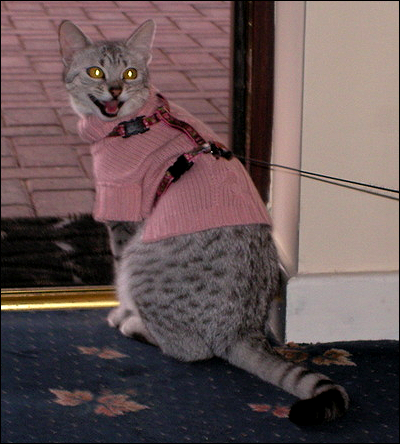
[Above - Qetesh at thirty-nine weeks old about to go out to play in the garden wearing her pink jumper.]
As winter began to approach I started to worry that she would not want to go out for walks and playtime anymore due to the terrible weather, especially the strong winds. After speaking to a friend that has an Ocicat whom told me about how her cat liked to wear jumpers, I decided to let Qetesh try out a jumper. Strangely, once we had worked out the best way of getting the jumper on her, she actually enjoyed wearing it, and once she was out playing in the garden she did not bother with the jumper at all. This meant that she could carry on enjoying the outdoors right the way through the winter, except for when it was raining, so it really helped, though she does not go for walks during the winter in case the weather gets too bad whilst we are out. At one point, when the jumper was still new, Qetesh even used to drag her jumper out the basket beneath her pram to cuddle up to, so it was clear that she was not disturbed in any way about wearing it.
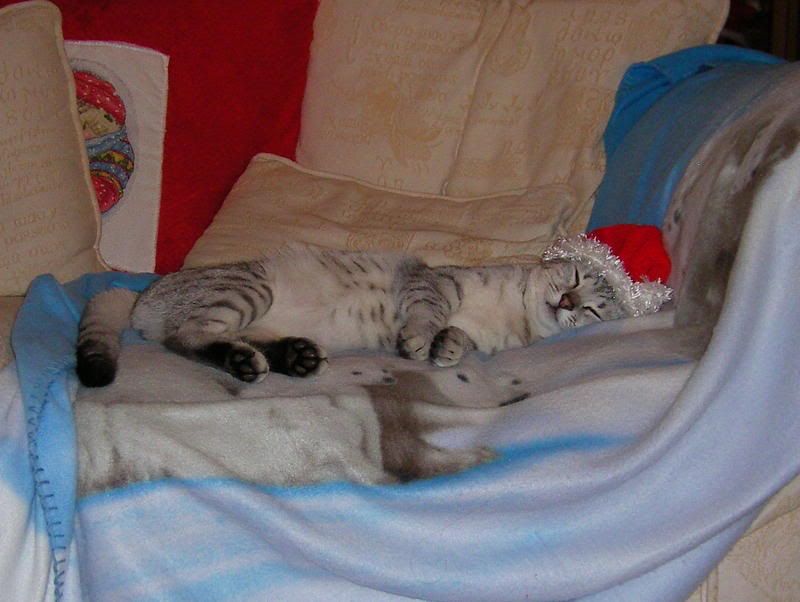
[Above - Qetesh at forty-four weeks old dressed up in her Santa hat.]
Qetesh sat around in amazement when the Christmas decorations were put up, but luckily she never once attempted to climb the tree or anything like that: she was quite satisfied to lay on the stool by the window and knock the snowman and reindeer magnets off the radiator onto the floor; sit beside the television and push the Christmas coasters off the cabinet; or chew the polar bear picture. She even had her own special decorations to play with: Christmas tree, snowflake balls, butterfly, and Christmas crackers. The butterfly and balls were easily her favourites, and you could happily pass huge amounts of time dangling the butterfly about for her to catch or throwing the balls about for her to chase. Christmas morning was very amusing, as at first you could see the look of disgust from her at seeing everyone up and about so early in the morning, and without even putting any food out for her! But as soon as she glided into the living room and saw her new toys laid out on the floor, she was soon back to herself, investigating the foreign objects. The fury mice that came in her Christmas stocking were a huge hit, and she spent much of the morning dashing around the house at full pelt with the mouse hanging out of her mouth, and she also spent a lot of time playing with her new fling-ama-string toy. At New Year she got to play with her IncrediBubbles, which had her prowling about in the bathroom for hours, pouncing on un-popped peach-flavoured bubbles, and begging for more to be blown about.
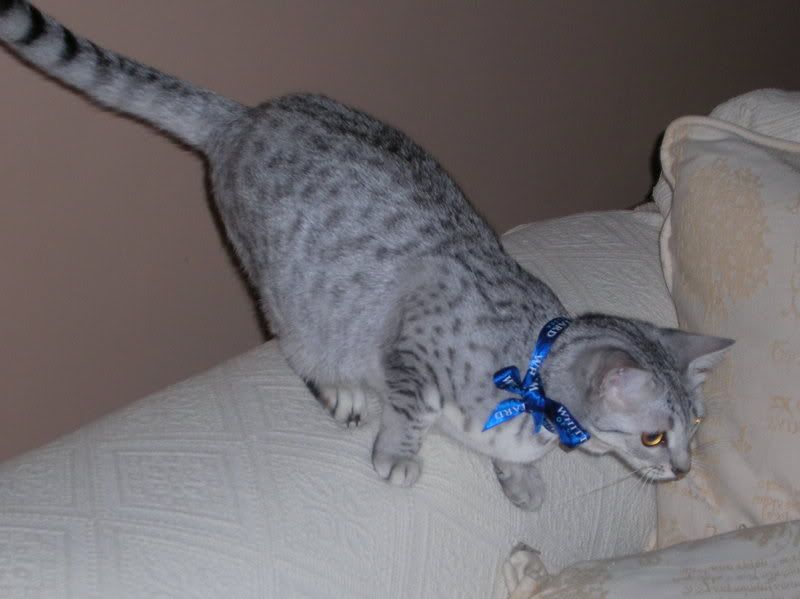
[Right - Qetesh at forty-eight weeks old ready to pounce.]
Over Christmas I did notice a spot of blood in the corner of her mouth, but there seemed to be nothing wrong with her and she was eating okay so I left her be, only to notice a week or so later that she now had no upper canine teeth at all: she must have lost her upper right one about that time. I took her to the vet, where I was told that the upper right canine tooth that had recently gone missing must have still been a kitten tooth, and not an adult canine like he originally expected, so she now has no upper canines and likely never will. She manages alright without them, though some foods she finds difficult to pick up and chew, so it is just a matter of getting used to what foods are best for her. Whilst she was at the vet she had to stay there for a few hours to get an abscess drained from her mouth and she was sent home with antibiotics. This is when we found out that antibiotics give Qetesh a poorly tummy, so from now on I have to get her pro-biotics any time she is to take antibiotics.
Qetesh has now passed her first birthday, discovering the joys of Da-Bird, which completely tires her out, and has still got plenty of growing to do yet, as the Mau does not reach its adult size until about two years old. She still also has amber eyes, but they seem to be gradually changing, just very slowly to keep me in suspense!
Diary
14th September 2009
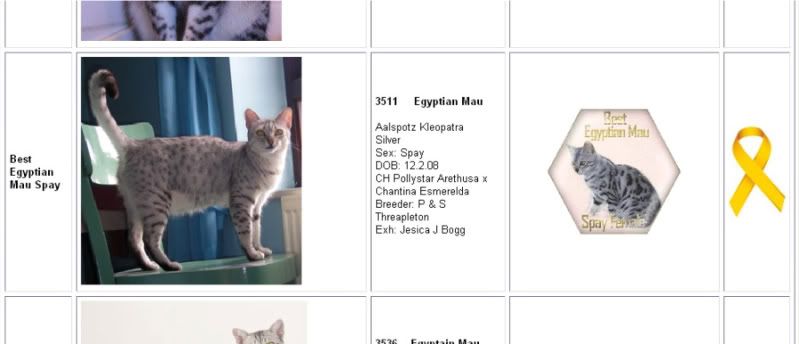
[Above - Qetesh at around thirteen months old winning "Best Egyptian Mau Spay Female in the Australian United Virtual Cat Show Bushfire Appeal (click on image to see larger).]
It has been a while since this diary was updated, so here goes. Qetesh has had a full bill of health for many months now, which I am happy to report, so I have thankfully had no worries there. In response to the Australian bushfires that occurred on the 7th February 2009, a virtual online cat show was opened to make money for Victoria Wildlife, by charging a small entry fee. Qetesh was entered into this competition in the category for pedigrees. I was not expecting too much, as she is purely a pet, but thought that it was a good cause to donate to, and it is always nice to get to show her off. So, I was so proud and stunned when, on the 1st June 2009, I found out that she had won Best Egyptian Mau Spay Female in the show.
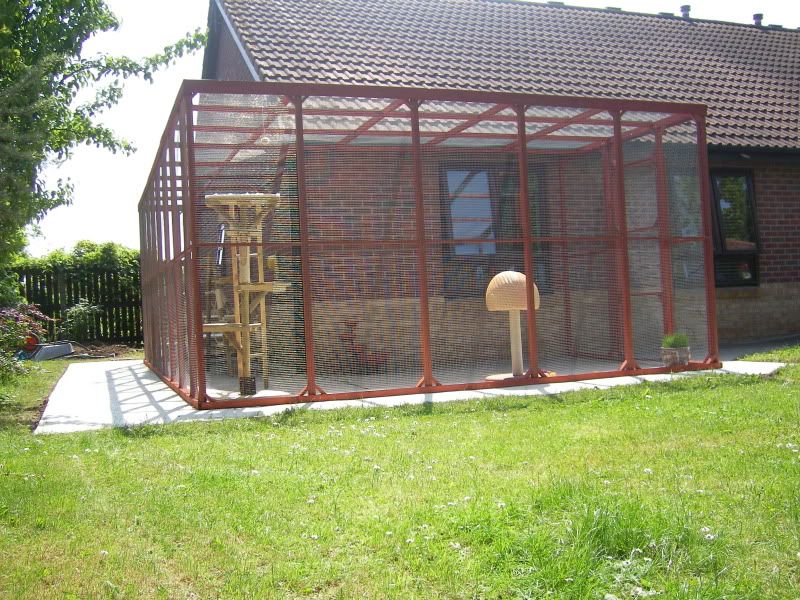
[Above - Qetesh's Cat Run built by ARB Creative.]
During last winter I had decided to get a cat run built for Qetesh the following winter, as she had been unable to go out to play when she wanted in the cold weather in case the wind and rain got too bad whilst we were out on our walks. I figured it was never too early to start making enquiries, so I asked advice from people that I knew had enclosures built for their cats: what they were built from; rough costs; and who they employed to have them built. Being told that most people had knocked their own enclosures up or had family members or friends do it, I was told that the best thing to do was to contact local joiners and handymen or professional run builders. This is where the fun began: I refused to employ a handyman, as I wanted it to be done professionally so there was less chance of it collapsing a week after it had been put up, so this left me with professional run builders or joiners. Run builders tended to be unbelievingly pricy and still wanted to keep to their own specifications of size and design, but very few joiners seemed interested in taking on the work because it was something they had never done before. When I finally found a joiner that I was happy with, I decided to go ahead and get the run built straight away, even though the original plans had been to wait until early next year, so Qetesh now has her own - very large - run to play in.
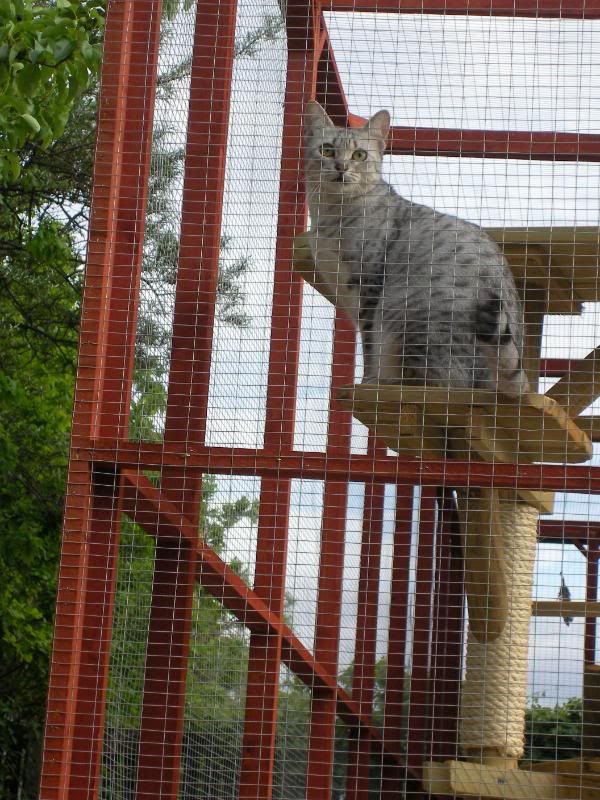
[Left - Qetesh at around fifteen and a half months old sitting atop of her polecat play station inside her new run.]
Seeing as Egyptian Maus are known for being a bit uneasy around strangers, I expected that having people here to construct the run would have been a nightmare for her, but she seemed to love it; sitting at the windowsill watching them work (perhaps this is just the general kitty nosiness, though?). I took her out for a walk around the garden on her harness a couple of times while they were here and it did not faze her one bit. In fact, I believe it has helped to make her more comfortable around people. As soon as the run was built she was straight out there to investigate her new surroundings. It was not long before she was demanding to be let out there first thing in a morning, letting herself in and out all day, and refusing to come in last thing on a night. A couple of times over the Summer months the window had to be left open all night to allow her to come and go as she pleased because she enjoyed being out there so much. At first she was still quite timid in the windy weather and come racing indoors once the breeze got up, but now she will stay out there in all weather: blazing sun, gusting wind, and even rain. Qetesh can literally spend hours on a high perch in the run watching squirrels and birds, befriending or trying to scare off neighbourhood kitties, and chasing insects and leaves around. She has also began a strange habit of climbing up the wire meshing of the enclosure to the top, which must be over seven foot tall, in order to stick her face in spider webs!
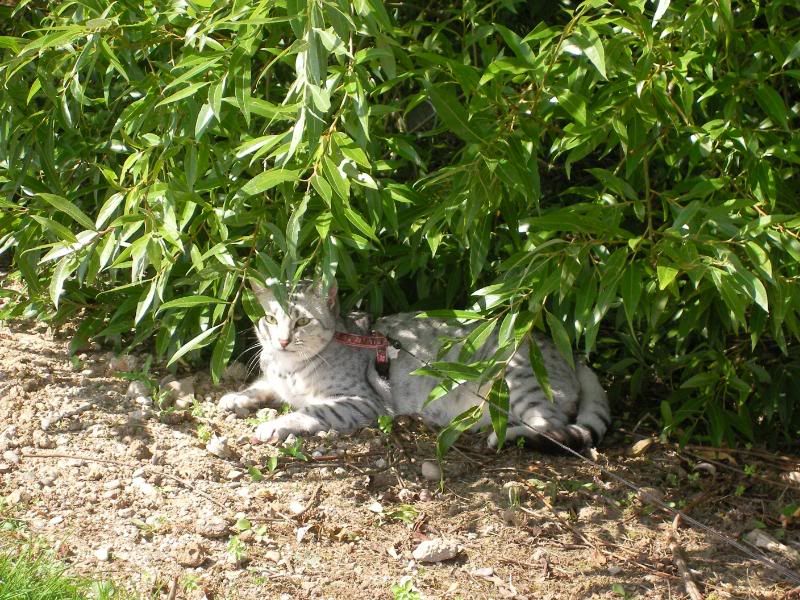
[Above - Qetesh at around eighteen months old laying under a bush for shelter from the sun at the public garden on Exeter Grove, Hull.]
On one of Qetesh's recent Sunday morning walks I took her into a public garden that people generally go to walk their dogs; it was quiet that day with no people or dogs about, so it seemed safe to let her enjoy the nature; hiding under bushes, squeezing between trees, and playing in the grass. She liked it that much that I took her back there the next week, though, all the excitement does make her very tired.
Merrydancer Kornflake "Petrie"
After spending two years living with me, Qetesh found herself with a new addition to the home; a sorrel-coloured, male Abyssinian kitten. When I first went to see the Abyssinian kittens at the breeder's house, I was surprised at how much more shy they were than the Mau kittens I had the pleasure of meeting previously, but they were still truly stunning felines. I picked the kitten I wanted, went home, and eagerly awaited the time that I could bring him home. The kitten is of show potential, with the pedigree name, Merrydancer Kornflake, but I have since given him the pet name, Petrie. I chose his name in reverence to an impportant archaeologist, William Matthew Flinders Petrie, who was awarded the title of "The Father of Archaeology" due to his significant discoveries throughout Egypt and elsewhere. On the 27th January 2010 Petrie had been born as part of a litter of four: Kookie, his fawn sister, is staying at the Merrydancer cattery; Kupcake (I believe is now affectionately called Milk), a usual brother; and a fellow sorrel brother called Kracker. Petrie's sire and dam have both now moved on from the Merrydancer cattery: Crystalpaws Frodo Baggins (born of Koperkat Drake Ramoray and Crystalpaws Lilac Ghost) and Highlight Jessica (born of Depussy Silver Cymbeline and Pinegrove Silver Callista). As the weeks passed while I was awaiting the new arrival, I worried more and more about how well Qetesh would get on with her new friend.
I brought Petrie home on the 30th April 2010. Following a long journey from Sleaford to Hull, he was happy to be finally let out of the carrier and free to investigate the kitchen and living room; he could not roam the full house right away as Qetesh had to be kept separated from him until he had familiarised himself with the new surroundings and was fully settled in. I spent some time getting Petrie used to his new home, and introduced him to some kitty toys to make him more comfortable, but eventually the inevitable had to happen: Qetesh and Petrie had to meet. I had Petrie enclosed in a large dog cage and let Qetesh into the room. She spent a while casually watching Petrie from afar, but gradually crept closer and began hissing at him. When he was let out of the cage she continued hissing and took up guard of the living room doorway to make sure he did not pass into what she obviously considered to be her territory. By the next day the hissing had died down and only occurred if Petrie physically invaded her personal space; by bounding up to her or entering a room that Qetesh had previously been occupying alone. Over the next few days Qetesh attempted to approach Petrie and initiate playtime, but Petrie had become slightly fearful and often responded to her with hissing and growling. Things gradually improved, though, with the two cats regularly enjoying a game of chase together, sleeping together, and even Qetesh grooming Petrie.
Within a week, they were both regularly playing together, and Qetesh began to take on a motherly role with him; checking up on Petrie when she had not seen him in a while and swiping her paw at him when he had been misbehaving. A couple of big fights broke out between them early on, though, which was quite worrying at first, but after getting some advice from the breeders, we were able to calm things down again. Fights seemed to appear from nowhere, with both cats squaring up to one another, bushing tails, growling, and hissing, before getting to the physical scuffle; Qetesh would often bite the nape of Petrie's neck and stand over him, like she was about to mount him, then kick him with her back legs before rolling around scrapping together. They had to be separated and kept in different rooms to cool off, but soon after they were crying for each other, wanting to play again. A mixture of jealousy and wanting to assert authority was what probably caused their arguements, so it was decided to have Petrie neutered early, get both cats some Bach Flower Remedy to calm them, and to make Petrie a "safe house" out of a cardboard box. These solutions appear to have worked, as they have never had anymore fights since, except in play, so they are much more friendly now. Both cats are kept in different rooms when left unattended, and started off by sleeping through the night in separate rooms, but now can sleep together.
Petrie has been here for almost six months now, so his character is really starting to show. He can often be seen carrying things around the house in his mouth; usually his toy mice and balls, but has been known to be mud, stones, leaves, twigs, and bird poop that he has brought indoors from the cat run. As well as enjoying playing in the run, he has also gone out in the garden on a harness; Petrie has not taken to it quite as smoothly as Qetesh did, as he would shuffle his bottom along the ground and roll about with the harness on, but he is still learning. The model-like walk that Petrie does is very amusing, as he seems to have perfected a swing to the hips as he glides around and tilts his head with an air of superiority; this makes him look though he really does believe he is royalty. Petrie has recently begun chirruping at his prey, often seen to be chirruping at a fly before pouncing on it, or chirruping at birds he can see out of the window or cat run. Hearing Petrie chirrup has now taught Qetesh to do it, too, as since I got her more than two years ago, she had never chirruped before now. One of the Abyssinian character traits is the affectionate head-butt. I had heard much about this, and had assumed it was reserved for their human slaves, but have found that Petrie will head-butt Qetesh in greeting, which did confuse her at first and angered her, so Petrie cooled off on his head-butting to Qetesh. Even though Petrie has potential to go to shows, at the moment he seems too afraid of being closed into cages, so I am concentrating on letting him enjoy the home-life with Qetesh for now, and see about showing him in the future.
After spending two years living with me, Qetesh found herself with a new addition to the home; a sorrel-coloured, male Abyssinian kitten. When I first went to see the Abyssinian kittens at the breeder's house, I was surprised at how much more shy they were than the Mau kittens I had the pleasure of meeting previously, but they were still truly stunning felines. I picked the kitten I wanted, went home, and eagerly awaited the time that I could bring him home. The kitten is of show potential, with the pedigree name, Merrydancer Kornflake, but I have since given him the pet name, Petrie. I chose his name in reverence to an impportant archaeologist, William Matthew Flinders Petrie, who was awarded the title of "The Father of Archaeology" due to his significant discoveries throughout Egypt and elsewhere. On the 27th January 2010 Petrie had been born as part of a litter of four: Kookie, his fawn sister, is staying at the Merrydancer cattery; Kupcake (I believe is now affectionately called Milk), a usual brother; and a fellow sorrel brother called Kracker. Petrie's sire and dam have both now moved on from the Merrydancer cattery: Crystalpaws Frodo Baggins (born of Koperkat Drake Ramoray and Crystalpaws Lilac Ghost) and Highlight Jessica (born of Depussy Silver Cymbeline and Pinegrove Silver Callista). As the weeks passed while I was awaiting the new arrival, I worried more and more about how well Qetesh would get on with her new friend.
I brought Petrie home on the 30th April 2010. Following a long journey from Sleaford to Hull, he was happy to be finally let out of the carrier and free to investigate the kitchen and living room; he could not roam the full house right away as Qetesh had to be kept separated from him until he had familiarised himself with the new surroundings and was fully settled in. I spent some time getting Petrie used to his new home, and introduced him to some kitty toys to make him more comfortable, but eventually the inevitable had to happen: Qetesh and Petrie had to meet. I had Petrie enclosed in a large dog cage and let Qetesh into the room. She spent a while casually watching Petrie from afar, but gradually crept closer and began hissing at him. When he was let out of the cage she continued hissing and took up guard of the living room doorway to make sure he did not pass into what she obviously considered to be her territory. By the next day the hissing had died down and only occurred if Petrie physically invaded her personal space; by bounding up to her or entering a room that Qetesh had previously been occupying alone. Over the next few days Qetesh attempted to approach Petrie and initiate playtime, but Petrie had become slightly fearful and often responded to her with hissing and growling. Things gradually improved, though, with the two cats regularly enjoying a game of chase together, sleeping together, and even Qetesh grooming Petrie.
Within a week, they were both regularly playing together, and Qetesh began to take on a motherly role with him; checking up on Petrie when she had not seen him in a while and swiping her paw at him when he had been misbehaving. A couple of big fights broke out between them early on, though, which was quite worrying at first, but after getting some advice from the breeders, we were able to calm things down again. Fights seemed to appear from nowhere, with both cats squaring up to one another, bushing tails, growling, and hissing, before getting to the physical scuffle; Qetesh would often bite the nape of Petrie's neck and stand over him, like she was about to mount him, then kick him with her back legs before rolling around scrapping together. They had to be separated and kept in different rooms to cool off, but soon after they were crying for each other, wanting to play again. A mixture of jealousy and wanting to assert authority was what probably caused their arguements, so it was decided to have Petrie neutered early, get both cats some Bach Flower Remedy to calm them, and to make Petrie a "safe house" out of a cardboard box. These solutions appear to have worked, as they have never had anymore fights since, except in play, so they are much more friendly now. Both cats are kept in different rooms when left unattended, and started off by sleeping through the night in separate rooms, but now can sleep together.
Petrie has been here for almost six months now, so his character is really starting to show. He can often be seen carrying things around the house in his mouth; usually his toy mice and balls, but has been known to be mud, stones, leaves, twigs, and bird poop that he has brought indoors from the cat run. As well as enjoying playing in the run, he has also gone out in the garden on a harness; Petrie has not taken to it quite as smoothly as Qetesh did, as he would shuffle his bottom along the ground and roll about with the harness on, but he is still learning. The model-like walk that Petrie does is very amusing, as he seems to have perfected a swing to the hips as he glides around and tilts his head with an air of superiority; this makes him look though he really does believe he is royalty. Petrie has recently begun chirruping at his prey, often seen to be chirruping at a fly before pouncing on it, or chirruping at birds he can see out of the window or cat run. Hearing Petrie chirrup has now taught Qetesh to do it, too, as since I got her more than two years ago, she had never chirruped before now. One of the Abyssinian character traits is the affectionate head-butt. I had heard much about this, and had assumed it was reserved for their human slaves, but have found that Petrie will head-butt Qetesh in greeting, which did confuse her at first and angered her, so Petrie cooled off on his head-butting to Qetesh. Even though Petrie has potential to go to shows, at the moment he seems too afraid of being closed into cages, so I am concentrating on letting him enjoy the home-life with Qetesh for now, and see about showing him in the future.
*** Special thanks to Paul and Sue Threapleton of the Aalspotz Cattery for entrusting me with one of their beautiful cats and for giving me much apreciated advice along the way.
Subscribe to:
Posts (Atom)

